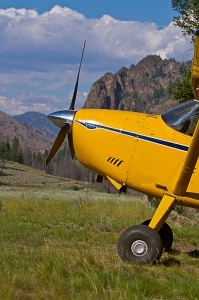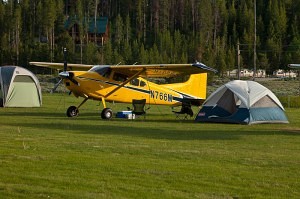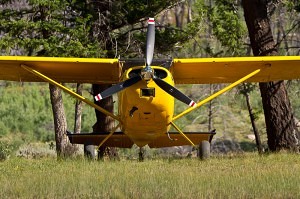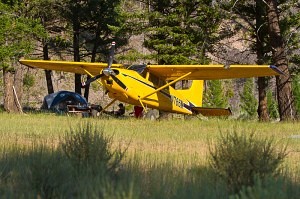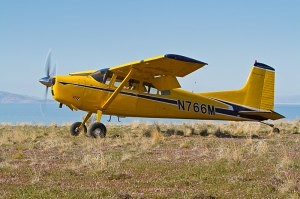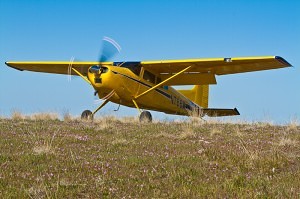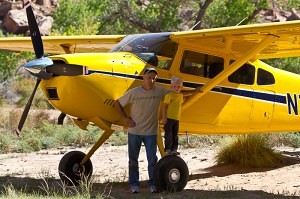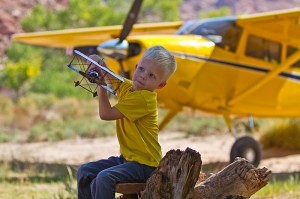Tailwheel Part 2
The 180 became part of my life and created a lot of good memories. Eight months go by, and one day I am talking with a friend of mine, and he mentions another tailwheel airplane, a 185, for sale at his home airport nearby. The price was right and I was immediately interested in learning more. It was described as a fixer upper and that appealed to me. As I thought about it over the next few days, I came up with a bunch of reasons why I should go see this tailwheel airplane and consider purchasing it. I knew it needed a lot of work, but that didn’t scare me, and I didn’t have any other projects going at the time.
When I was rebuilding the 180 I maintained the only reason I would ever consider selling it was if I could replace it with a 185. Only then might I might be willing to let it go. It seemed like idle talk and was never a plan for the future. I wasn’t looking for one and never believed that I could ever afford or find a 185. I guess you need to be careful about what you think about though, because here I was, suddenly thinking about buying this 185 and I hadn’t even seen it yet.
As expected, it was in rough condition, but it was nothing I was intimidated by. This was a flying airplane with all the parts. After the 180 this seemed like a simple deal. As I inspected the aircraft all I could see was the potential of it and so it was no surprise that I made an offer, we negotiated and I was soon the owner of two Skywagons.
Knowing I ultimately couldn’t keep both airplanes and would have to sell one of them, my rational self decided I would keep both until I had flown them each enough to be sure which one I would want to keep.
I arrived a few days later to pick up the 185 and flew the 15 minute flight back to my airport. A subtle yet definite difference in flying characteristics was noticed as soon as I took off and my decision to sell the 180 was made. It took me less than 5 minutes to come to this conclusion. I had some very mixed feelings though, because the 180 had become a part of me and I felt disloyal, like I was turning my back on a friend. And, it was so nice and new it seemed like I was trading down. It even smelled new. I was attached to it and the decision to sell did not come easily, but I could not deny the confidence I had in my decision to buy the 185. It was apparent to me that this would be a good decision.
Fuel injection, 300 horsepower, a much high useful load and a heavier, stable feel in the flight controls are the major differences between the two airplanes. I never second guessed my decision to sell the 180, but I did have to come to grips with it.
Another consideration that influenced me was the financial aspects of the deal. I wasn’t sure how much the 180 was really worth but I knew it was an unusual and rare airplane. I had never seen one as perfect as mine so I put a high value on it, higher than any I had seen at the time. If it sold for that amount it would give me the money to make the 185 equally as nice and still have money left over. At least that’s what I thought.
I never officially advertised the 180 but I did put the word out that it was soon going to be for sale. A couple weeks went by and the phone rang. The fellow said he had heard about it and would like to come look at it. He arrived a few days later to see the plane. After some questions and a little poking around the airplane he ask me, “how much?” Trying to sound firm and confident I gave him the number. He reached for his wallet, pulled out a counter check and wrote it out. No questions, no haggling, no hassle. It was done.
I tried to hold back my emotions but inside I was hurting. I had just exchanged this amazing and beautiful machine and this part of my life for a piece of paper. As excited as I was about having resources for my new project, I also felt deflated and sad.
The airplane stayed in my hangar for a couple weeks until the new owner could come get it. When the day came, it was tough to see it go, but good to have it out of sight. Now I could turn my full attention and affection toward the 185.
I started tearing things apart, buying parts, fixing things, stripping paint and cleaning everything I could. I quickly became as obsessed with this project as the one before. However, with this endeavor I wanted to keep the airplane generally airworthy. I never wanted it to get so far apart that it wouldn’t be available to me within a reasonable period of time. As a result I worked on sections of the plane in 2 or 3 week segments and then reassembled everything to get our flying again. I had developed a taste for flying in the backcountry and didn’t want to miss out on opportunities to go places as they came up. I flew the airplane a lot in various stages of repair and with big sections of paint removed. Interior panels and headliner was removed as I worked through each area. Keeping the airplane legal was a challenge and I had to do multiple weight and balance and log entries as I went along with the project.
The airplane had been previously owned by the Dept. of Interior in Alaska and had extensive records. I received boxes and boxes of work orders and engineering data that contained every detail of the airplanes history for the last 25 years. The aircraft is a 1970 model A185E but the government had updated the aircraft in most every way. It had operated on floats and skis most of its life and had nearly 6000 hours total time. I bought the airplane from a fellow who had purchased it at a government auction. He intended to turn it for a quick profit, which is where I came into the picture. The old airplane was rough, or as I more affectionately referred to it as it “had character”. It had very worn interior, missing instruments, poor paint and a high time engine and prop. The windows were cloudy and crazed and there were dings and patches on fuselage skins and cowlings. Various antennas for tracking wildlife had been mounted on the aircraft in multiple locations leaving marks, holes and nut plates when they had been removed. The airplane had been worked hard throughout its life and maintenance had been neglected over the past few years. It appeared that before it was sold many of the better parts of the plane had been exchanged for more worn and less desirable parts.
On the positive side I had a good solid airframe with a lot of updates. I could see what it could become. I loved the way it flew and even though I knew it would never be as “new” as the 180 had been when I finished it, I was still happy with my decision to own the 185.
Section by section I stripped off all the old paint. I have stripped plenty of aircraft over the years and it is never a fun job. This was no exception, but there is something satisfying about taking off old bad paint and finding shiny, beautiful aluminum underneath. It’s a terrible job though and its one that never seems to end. The nasty chemical stripper goes on and seems to remove about 80% of the paint on the first application. Then you apply another coat that removes 80% of what is left. Another application removes 80% again and so it goes. The job never seems to get finished. Even when you are “done” you continue to find little specs and areas that still need work.
When the paint was finally removed there came a time when I knew the airplane would go out of service for a longer time because several other jobs would be done in conjunction with the paint. All the windows, instrument panel and interior were removed. This would be the best opportunity to take care of all the clean up and repair behind the scenes. All the wiring behind the panel got cleaned up, replaced and organized as was needed. Over the years this area often becomes a real mess as repairs and modifications are made. It is an area that’s difficult to access when the plane is together. This airplane was no exception and had a lot of dead end, disorganized and messing wiring throughout. While everything was apart each wire was traced, repaired as needed and then tie wrapped in looms. No more spaghetti behind the panel. Switches, circuit breakers and cables can all be replaced easily and repairs are relatively easy while it is apart. This was all accomplished as well as some radio modifications and installation of an engine monitor and fuel flow instrument. New insulation and windows were also important for me to install before painting. Next, a metal instrument panel was cut, painted and silkscreened, to be installed replacing the old panel and plastic over lays.
I disassembled every part of the seats, blasted each part and painted them. Then I reassembled them with new hardware and bushings.
While my upholstery guy worked on the interior my attention focus on prepping the plane for paint. The airplane would be etched and alodined, which is a process to make the paint stick better and provide corrosion resistance under the paint. All the flight controls were removed and the entire tail section disassembled. Endless hours of masking was necessary to protect areas that should not be painted and lay out stripes for the trim. Next my hangar needed to be made ready. Since I didn’t want overspray on the floor and everywhere else, I had to lay protective plastic out and then cover everything. Overspray travels far and wide and unless you cover everything you care about you will be faced with a real mess. Every time I have done this job it has felt like it will never end. Finally though, everything is masked, the airplane positioned and all the removed parts are hung for painting. The hangar was sectioned off with a big curtain and we were ready. My good friend Glen is a master painter with something like 60 years of experience and he always makes himself available to help with painting jobs. I have done the painting before, but I don’t seem to be patient enough to get the paint on smooth and without runs. I think Glen could do it with his eyes closed. He has been such a great help over the years.
I chose to use the same scheme I had put on the 180 because I like it and had designed it myself. I still like it, but sometimes wish I would have come up with a new design and color scheme this time.
After 3 separate paint episodes, the yellow, blue and white colors were finally all on the airplane and the masking paper came off. The results were good as usual and the next couple weeks I spent all my spare time reinstalling all the removed parts. The interior went in and soon it was ready to be out flying again.
This airplane has since been a real source of enjoyment for me. Many trips to Mexico, Idaho and Utah airstrips have been made and it has never let me down. I have loaded the airplane to its max capacity with 4 adults and camping gear many times, and it performs well. I have found it to be very capable but I have also learned that like any airplane you must respect it. Even with 300 horsepower, stol abilities and a high useful load, a pilot can not be too careful, allowing the airplanes capability to influence over confidence. Pilots too often allow themselves to believe the 300 horsepower engine will pull them out of any situation and make them invincible. Hot temperatures, high altitudes and heavy loads make any aircraft perform poorly and the 185, as strong as it is, is not immune. Airmanship and judgment are required in all aspects of aviation no matter how powerful of an airplane you fly.
Once the airplane was back together and usable again I quickly got back to my flying habit. I sought out every dirt strip I could find and learned all I could about the plane. Now, a few years later, I still have work to do to it. The engine still needs to be overhauled and everything firewall forward cleaned up and renewed. Since I finished the paint and interior I have not wanted to be without the airplane long enough to do all the work I would like to. Each year that has passed I have planned to do the rebuild but have ended up putting it off. As I have flown the airplane it has run perfectly, not leaked oil and has easily passed each inspection during the annuals. Its done so well I often wonder why worry about an overhaul right now? Once again, this winter I hope to do the engine overhaul, not that I am so worried about it’s airworthiness, but I have a strong personal desire to get everything overhauled, cleaned up and all the little details fixed.
The 185 is one of the most robust and capable airplanes I have been around. It can carry close to its empty weight and can be off the ground and climbing or on the ground and stopped in short distances. It has manual flaps and a trimable tail giving it a large C,G, range. This also makes it a handful to fly when it is out of trim. Go arounds are very heavy on the controls until the trim is returned to a more neutral position. This requires a lot of strokes on the wheel while holding significant forward pressure on the control wheel. Its feels like it should be a two handed job to hold the airplane level but one hand needs to be running the trim wheel. This is something that should be practiced so you know how these forces feel when called upon to initiate a go around.
The flat spring landing gear works great for absorbing bumps when landing on rough strips and larger 8.50s tires provide nice rough field service also. The benefits of the spring gear also can be your enemy as it can launch the aircraft back in the air if you land with any amount of vertical descent. These airplanes are wonderful wheel landers and once you learn to effectively do them you will love them. It 3 points nicely also but in my opinion there is not much that is more pretty than a well executed wheel landing, not to mention the satisfaction it brings.
The 185 is an incredible machine and I feel privileged to own mine. I really enjoy flying it and have created memories with it that will stay with me forever. Plus, when you open the hangar door you will not find any other airplane that greets you with such a majestic attitude, beautiful lines and eagerness to fly…at least that’s how I feel.
Tailwheel Part 1 is available here if you missed it, and the story concludes with Tailwheel Part 3.

